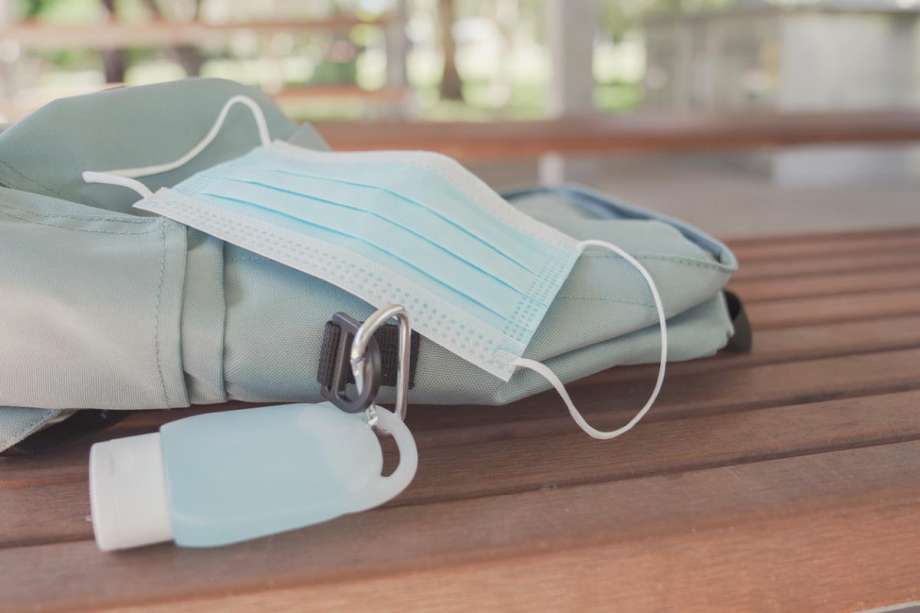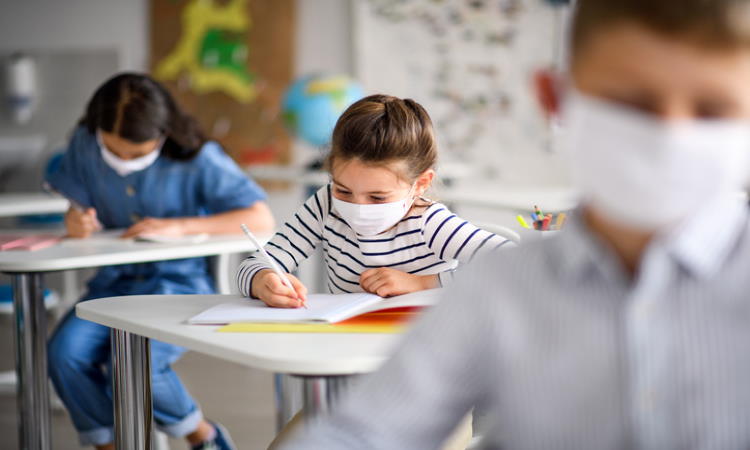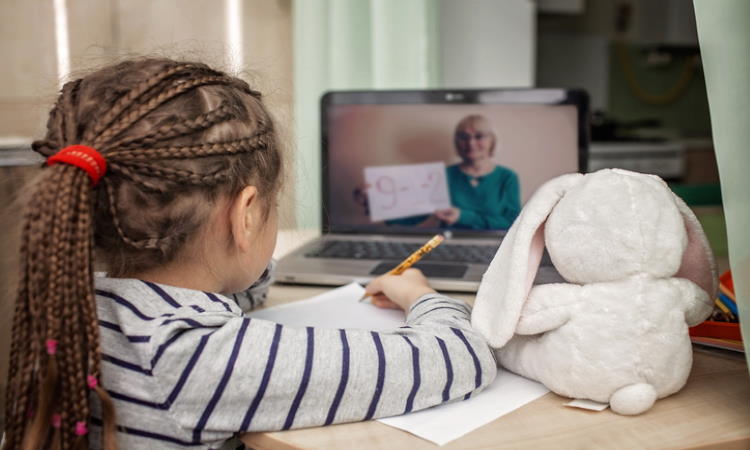How to Talk to Your Kids About the Upcoming School Year

This summer parents have been waiting anxiously for their school districts to release reopening plans. Afterall, until we know what school will look like, we can’t help our children get ready! It’s hard to plan when you don’t know what you are planning for. Some schools opened their doors last week, and over the next few weeks more schools will begin (whether online, in person, or a combination of both).
More: At-Home Learning Resources for the COVID-19 Outbreak
Because the 2020-2021 school year will be unlike any other, it’s important to talk to your child about how to be safe and responsible. If there is one “must have” on the back-to-school list this year, it’s not a new set of markers, it’s a resilient child. We drew on our own teaching and parenting experience, and talked to experts about what to say to your kids as they head back to school.
If Your Child Is Going Back To School In Person…

If your kids are going back to a classroom, their experience is going to be very different than last year. In most states students will wear masks. Students will wash their hands and sanitize their desk and supplies. They won’t be able to share with their classmates or be closer than six feet from them. Some students won’t leave their classrooms, and will eat lunch at their desk.
Your kids might feel anxious or worried about making a mistake or getting sick. Talk to your kids about how they feel. If they aren’t sure how to share their feelings, use a feelings chart. Empower them with coping mechanisms and strategies, and review safety protocols.
Be Your Child’s First Teacher
It is important to help your kids learn and understand how to make responsible choices, and follow school safety protocols before school starts. If your kids aren’t used to wearing masks, talk to them about why it is safe for them and other people if they do. Start wearing masks at home for a little bit at a time so it doesn’t feel as new or uncomfortable when it’s the first day of school.
We love this COVID-19 mini-book and set of coloring pages that helps students understand the virus and how to behave safely at school and make responsible decisions. It was designed by a third grade elementary teacher, and mom of two, who is on the advisory board of our sister site, TeacherVision.
Develop The Solution Before The Problem
Dr. Fran Walfish, a family and child therapist, recommends parents role play different scenarios with their children. You can use these scenarios to brainstorm solutions to potential challenges at school. “Equip them with the strategies they need before they are in a challenging situation,” she says. She suggests posing scenarios like, “What would you do if a classmate came up to you and asked to borrow a pencil?” and “What would you do if a classmate grabbed a basketball out of your hands?”
Do A Dress Rehearsal
Sports teams practice before big games. Actors rehearse before opening night. One of the most effective ways to talk to your child about going to school during COVID-19, is to walk them through the experience. Before school starts, practice the routine, which will now include masks, hand sanitizer, and keeping distance. Help your child visualize what their experience will be like, which will lower anxiety (Check out 5 Phrases to Say to Your Anxious Child About Schools Reopening).
If Your Child Is Going Back To School Online and In Person...

Many schools are offering a hybrid learning experience where students attend school in person some days, and learn online at home on others. From a teacher’s perspective, one of my concerns with this approach is that it will be difficult for students to get into a routine. The only certainty that we have right now is uncertainty. Children need repetition and consistency, Dr. Walfish echoes my belief, and shares, “Young children thrive on repetition of a regular routine so they know what to expect. When it’s delivered it builds their sense of internal security and trust.”
Take The Guessing Game Out Of The Day
If students are going back and forth between their classroom and learning online at home, they might feel confused about the schedule. Heather Aulisio, a veteran teacher, and mom suggests that you post a large visible schedule at home and color code it depending on hybrid days vs. at home days. “Keep wake up times and bedtime consistent whether kids are going to get on the bus or head to school or not,” she says. Expect some pushback from you kids, who may feel that “school rules” don’t apply at home. Be patient. Provide positive reinforcement when you see your kids doing well, and be compassionate if they have a setback.
Who Is In Your Corner?
If your child is returning to school, talk about the teachers and adults that they have a good relationship with. Remind them what resources there are at school if they are feeling sick or worried. Talk about who the school nurse and counselor are, and how and when they can see them. This will also help you feel better, as you know that when your child is at school, they have several adults supporting them. You can also reach out personally, and ask them to connect with your child within the first week of school. If your child will be a new student, find out what support there is at their school. Reach out, and connect with these adults, and help your children learn who they can talk to.
If Your Child Is Doing Online Learning At Home…

Many parents felt that distance learning was a failure. They expressed that their kids are behind. It is important to keep in mind that schools had only a few weeks (for some just a few days) to transition from a regular school year and schedule to distance learning. Schools have had more time to plan and prepare. Online learning isn’t homeschooling. It isn’t your job to develop curriculum, plan lessons or take over as your child’s teacher. Your job is to help your child adjust to learning online, which means being in partnership with their teacher.
Your Child’s Teacher Wants To Talk To You
I taught middle and high school English for eight years, and I can say that I appreciated and was grateful for parents who were involved in their child’s education. When parents emailed me with questions, concerns or to ask for my help, I saw it as an opportunity for us to work together (it takes a village after all). There is a difference between feedback and complaining. If an aspect of online learning isn’t working well for your child or your family, reach out to the teacher. Chances are she needs your feedback as this type of teaching is likely new to her. Teachers have thick skin and don’t get offended easily. If you think there are too many tech tools with different logins and passwords, speak up. If you think she is doing great, share that too!
Daily Check-Ins
When your children are learning online, it is important that you check in and help facilitate their learning (especially if they are younger). There are some quick and easy check in strategies that you can use to provide consistency and routine while your kids are learning at home. At the beginning of the week, set a goal with your child. I like to use “I can” because that language is empowering and positive. The goal might be focused on behavior and work habits, “I can refocus when I get distracted by getting up and moving and then returning to my work. “ The goal might be focused on academics, “I can show my work on my math assignments.” Have your child write their goal on a post-it note and stick it near their computer or tablet. Check in throughout the week, and circle back on Friday. How did it go?
Another strategy is using Glows and Grows. At the end of an online learning day, give your child positive feedback, or a glow. You might say something like, “I am proud of you for how hard you worked during your Zoom class. I noticed that you asked questions and were participating.” Then, give your child suggestions for what they can work on, or a grow. You might say something like, “I noticed that you were frustrated with the amount of work your teacher assigned this week and you decided not to complete it. How do you feel about that choice? What were the consequences?
There is no right or wrong conversation to have with your kids to help them prepare for the upcoming school year. What is most important is to keep the lines of communication open, and help your child understand how to be safe, responsible, and resilient during these unprecedented times.
Pin it to save for later:

